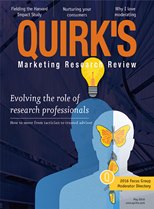Marketing research and insights news and information. This issue's keywords: auto insurance; video-on-demand; mobile surveys; retail apps; Millennials; consumer satisfaction studies
Fifty-one percent of quoted auto insurance shoppers provided inaccurate information either by accident or intentionally shows a consumer survey by San Francisco online insurance platform CoverHound. Many shoppers requested a quote without providing correct information or forgot to include some important information to carriers. This could be due to omissions or misrepresentations of information, according to the findings. Millennials provided inaccurate information by accident or intentionally 6 percent more than their Baby Boomer counterparts. When comparing shoppers who self-reported as "currently insured" and "uninsured," "currently insured" shoppers are 5 percent more likely to omit or provide inaccurate information either intentionally or by accident. This may be due to shoppers misrepresenting or misunderstanding their "currently insured" status. Compared to lower-risk shoppers, only 2 percent more of the higher-risk shoppers omitted or provided inaccurate information. Nearly the same percent of male and female shoppers omitted or provided inaccurate information either intentionally or by accident.
Among the 65 percent of global respondents who watch any type of video-on-demand (VOD) programming – which can include long- and short-form content – 43 percent say they watch at least once a day, shows a report by Nielsen, New York. Additionally, 49 percent of Generation Z (aged 15-20) and 48 percent of Millennial (aged 21-34) respondents report watching on-demand content daily or more often than their older counterparts, with 21 percent of Silent Generation respondents (aged 65+) and 26 percent of Baby Boomers (aged 50-64) saying they watch at least once a day. Thirty-eight percent of Generation X respondents (aged 35-49) said they view daily. Eighty percent of global respondents who watch on-demand content say they view movies, followed by on-demand TV programs (50 percent). When it comes to popular program genres, comedies (38 percent) and original series (32 percent) rank the highest globally, followed by sports and documentaries (31 percent each). Twenty-two percent of global respondents say they watch short-form video content (videos of 15 minutes or less in length).
Eighty-three percent of respondents said they would be willing to spend five minutes or less on a mobile survey, according to a recent survey on respondent preferences toward mobile surveys and survey invites by U.K. research technology firm OnePoint Global. When asked how they would prefer to receive a survey invite, e-mail and SMS invites ranked higher than survey invites at the end of a call, receiving a phone call or face-to-face. Additionally, the survey found that only 16 percent of people answer their phone if they don't recognize the number, while 43 percent of people never answer the phone if the number isn't in their contacts. The survey also shows that as many as 60 percent of people read a text message from a number they don't recognize and 79 percent of respondents said they never check their spam folder or check it less than once a week.
A report by U.K. mobile app developer Apadmi shows that 31 percent of consumers currently use retail apps while in-store but 41 percent more would do so if the app enhanced their in-store experience. Twenty-nine percent of consumers would share details such as their location with a retail app if they received in-store offers and incentives in return. The report shows that the top four favorite features of retail apps include the ability to browse products (53 percent), offers and promotions (49 percent), loyalty program (45 percent) and click-and-collect (42 percent). Additionally, 80 percent of consumers would collect loyalty points on their mobile, including when they complete tasks as they walk around a store. Currently only 20 percent interact with a retail loyalty program on their mobile device. Forty-three percent said they would be more likely to download a retail app if it allowed them to browse and buy products quickly and easily while 74 percent said they would be more likely to download an app if it were free of charge. Slow and unresponsive mobile apps would cause 71 percent to stop using them and 17 percent said mobile retail apps offered a better experience than a Web site.
Overall, across 15 industries studied, Millennials are generally more satisfied consumers (five points higher, on average) than Boomers (born 1946-1964), according to a report on the customer experience preferences of Millennials – those born between 1982 and 1994 – by Westlake Village, Calif., researcher J.D. Power. The difference is most prominent in the utilities (+37 points), health care (+28) and telecom (+13) industries. Additionally, the report shows Millennials have the lowest tolerance for errors and delays of any other generation studied. However, when there is a problem and it is resolved fully, Millennials are substantially more likely than Boomers to reuse a product or service. Millennials are also most likely to make a purchase decision based on value for money across virtually every product category, compared to other generations that tend to buy things for status, image or brand loyalty. Lastly, the report shows Millennials are less concerned than other generations about privacy. They accept the erosion of privacy as inevitable and are generally willing to have their information collected if it comes with benefits in the form of targeted offers and personalized services.
These reports were compiled from recent issues of the Daily News Queue, a free e-newsletter digest of marketing research and insights news and information delivered each business morning. Not already in the Queue? Sign up here!
